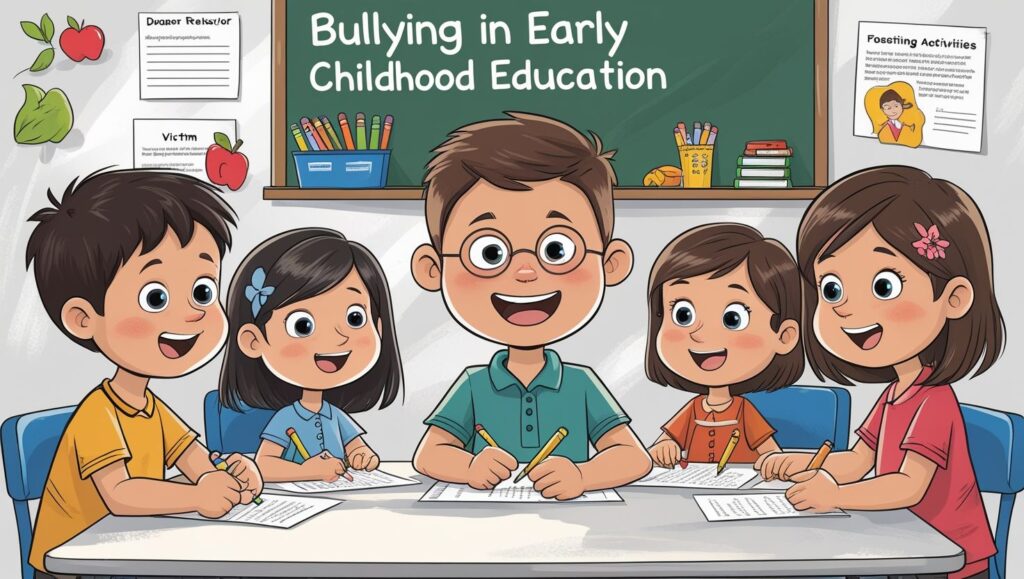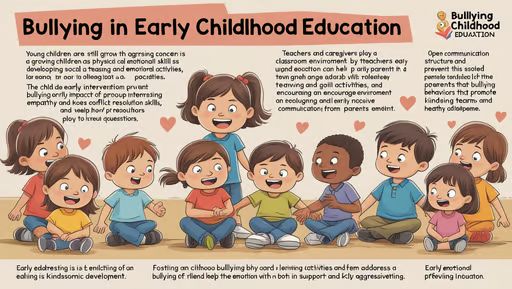Bullying in Early Childhood Education, Bullying is a pervasive issue that can manifest at any stage of life, but its emergence in early childhood education is particularly concerning. Early childhood, typically defined as the period from birth to eight years old, is a critical time for social, emotional, and cognitive development. During these formative years, children learn how to interact with others, manage emotions, and navigate social dynamics. However, when bullying enters the picture, it can disrupt these processes, leaving lasting effects on both the victim and the perpetrator. Understanding the nature of bullying in early childhood education, its causes, and its consequences is essential for educators, parents, and policymakers to create safe and nurturing environments for young children.
Understanding Bullying in Early Childhood
Bullying in early childhood education often differs from bullying in older age groups. While older children may engage in more overt forms of bullying, such as physical aggression or verbal harassment, younger children may exhibit behaviors that are less obvious but equally harmful. These behaviors can include exclusion, name-calling, teasing, or even subtle forms of manipulation. Because young children are still developing their social and emotional skills, they may not fully understand the impact of their actions on others. This lack of awareness, however, does not diminish the harm caused by bullying. In fact, early exposure to bullying can set the stage for more severe issues later in life, such as anxiety, depression, and difficulties in forming healthy relationships.
One of the challenges in addressing bullying in early childhood is identifying it. Young children may not have the language skills to articulate their experiences, and their behaviors may be misinterpreted as typical childhood conflicts. For example, a child who repeatedly excludes a peer from play may not intend to be malicious but may lack the social skills to include others. Similarly, a child who uses physical aggression may be mimicking behavior they have seen elsewhere rather than intentionally trying to harm someone. Educators and caregivers must be vigilant in observing children’s interactions and intervening when necessary to prevent bullying from taking root.
Causes of Bullying in Early Childhood
The roots of bullying in early childhood are complex and multifaceted. One contributing factor is the environment in which children are raised. Children who witness aggression or hostility at home, in their communities, or through media may be more likely to replicate these behaviors in their interactions with peers. Additionally, children who experience neglect, abuse, or inconsistent discipline may struggle with emotional regulation and resort to bullying as a way to assert control or gain attention. Another factor is the developmental stage of the child. Young children are still learning how to share, take turns, and empathize with others, and these skills take time to develop. Without proper guidance, children may resort to bullying as a way to navigate social situations.
Peer influence also plays a significant role in bullying behavior. In early childhood education settings, children are often grouped together for extended periods, and the dynamics within these groups can influence individual behavior. A child who observes others engaging in bullying may be more likely to join in, either to fit in or to avoid becoming a target themselves. Similarly, children who are perceived as different—whether due to their appearance, abilities, or background—may be more vulnerable to bullying. This highlights the importance of fostering an inclusive and accepting environment in early childhood education settings.

Consequences of Bullying in Early Childhood
The consequences of bullying in early childhood can be profound and far-reaching. For the victim, the experience of being bullied can lead to feelings of fear, shame, and isolation. These emotions can interfere with the child’s ability to form positive relationships, engage in learning, and develop a healthy sense of self-esteem. Over time, the effects of bullying can contribute to mental health issues such as anxiety and depression, as well as academic difficulties. In some cases, the trauma of being bullied can persist into adulthood, affecting the individual’s ability to trust others and navigate social situations.
For the perpetrator, engaging in bullying behavior can also have negative consequences. Children who bully others may struggle with emotional regulation and impulse control, which can lead to difficulties in school and relationships. Without intervention, these behaviors can escalate over time, increasing the risk of delinquency and antisocial behavior in adolescence and adulthood. Additionally, children who bully others may experience social rejection, as their peers may avoid them due to their aggressive behavior. This can further isolate the child and reinforce negative patterns of behavior.
Preventing and Addressing Bullying in Early Childhood Education
Preventing and addressing bullying in early childhood education requires a proactive and multifaceted approach. One of the most effective strategies is to create a positive and inclusive classroom environment where all children feel valued and respected. Educators can achieve this by modeling empathy, kindness, and respect in their interactions with students and by encouraging children to do the same. Teaching social-emotional skills, such as how to share, take turns, and resolve conflicts peacefully, can also help reduce the likelihood of bullying behavior. Additionally, educators should be trained to recognize the signs of bullying and intervene promptly when it occurs.
Parental involvement is another critical component of preventing and addressing bullying. Parents play a key role in shaping their children’s behavior and attitudes, and they can reinforce the lessons taught in the classroom by promoting kindness and empathy at home. Open communication between parents and educators is essential for identifying and addressing bullying behavior early on. Parents should also be encouraged to monitor their children’s media consumption, as exposure to violent or aggressive content can influence behavior.
When bullying does occur, it is important to address it in a way that is constructive and supportive for all parties involved. This may involve working with the victim to rebuild their confidence and sense of safety, while also helping the perpetrator understand the impact of their actions and develop more positive ways of interacting with others. Restorative practices, such as facilitated discussions or peer mediation, can be effective in resolving conflicts and repairing relationships. In some cases, additional support from mental health professionals may be necessary to address underlying issues that contribute to bullying behavior.
The Role of Policy and Advocacy
In addition to individual and classroom-level interventions, addressing bullying in early childhood education requires a broader commitment from policymakers and advocates. This includes implementing anti-bullying policies in schools and early childhood education centers, as well as providing resources and training for educators and caregivers. Public awareness campaigns can also play a role in reducing bullying by promoting positive social norms and encouraging bystanders to speak up when they witness bullying behavior. By working together, educators, parents, policymakers, and advocates can create a culture of respect and inclusion that prevents bullying and supports the healthy development of all children.
Conclusion
Bullying in early childhood education is a serious issue that demands attention and action. While young children may not fully understand the impact of their actions, the consequences of bullying can be long-lasting and detrimental to both the victim and the perpetrator. By understanding the causes and consequences of bullying, and by implementing proactive strategies to prevent and address it, educators and caregivers can create safe and nurturing environments where all children can thrive. Through collaboration, education, and advocacy, we can work towards a future where bullying is no longer a threat to the well-being of our youngest learners.

8 thoughts on “Bullying in Early Childhood Education”
Comments are closed.